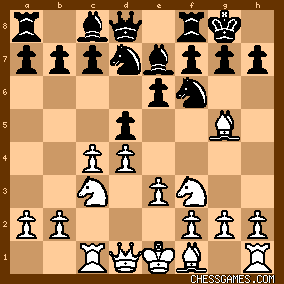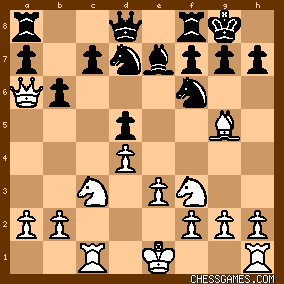| KEG: Romanovsky was struggling to hang on for much of the game, but then Tselikov tanked and fell apart and erred badly on moves 23, 25, 26, 27, and 28, turning a game in which he was close to winning to a catastrophe. As so often is the case, the superior tactician turned the tables. 1. d4 d5
2. Nf3 Nf6
3. c3 e6
4. Nc3 Nbd7
5. Bg5 Be7
6. e3 0-0
7. Rc1

click for larger viewA standard QGD opening position.
7... b6
I have never been fond of b6 in such positions (I prefer h6 or c6), but b6 it is certainly playable, though it got Romanovsky into trouble in this game. 8. cxd5 exd5
Here's the rub. Playing 7...b6 allows White to play 8. cxd5 thereby blocking the diagonal for the Bishop when it goes to b7. Of course, 8...Nxd5? falls to 9. Nxd5! 9. Qa4
Later played by Capablanca in Game 5 of his 1921 World Championship match against Lasker. Developing the f1 Bishop to e2, d3, or b5 looks better. But the text can lead to exciting possibilities, as both the Capablanca-Lasker game and this one showed. 9... Bb7
The crucial (and to my mind better) move is 9...c5. This can entail loss of a pawn, but 9...Bb7 10. Ba^ (which Lasker said he didn't want to face) also presents challenges for Black. Capablanca played in response 10. Qc6 and claimed he had found--over the board--a refutation of 9...c5. For a good discussion of the merits of this line and for a better assessment of the position, see Kasparov's analysis of the Capablanca--Lasker game. As I believe Kasparov has demonstrated, Lasker's loss was the result of a later error and not because of 9...c5 (Capablanca's claim notwithstanding). 10. Ba6
The move Lasker did not want to face.
10... BxB
11. QxB

click for larger viewWhile Black's position is defensible, it is easy to see why Lasker didn't fancy this line. 11... c5?!
Less convincing now than two moves earlier. 11...h6 or 11...c6 or 11...Re8 were better. 12. 0-0 Qb8
This attempt to obtain counter-play on the Queen-side was misjudged and the beginnings of Romanovsky's real problems in this game. 12...h6 was simpler and better. 13. Rfd1

click for larger view13... Bd6?
This could have lost the game for Romanovsky. He had many decent alternatives: e.g., 13...h6; 13...c4; 13...Rd8. White is better in all such cases, but the text should probably lose against best play, the position now being: 
click for larger viewBut here, as I will discuss in my next post on this game, Tselikov missed his chance. | 




